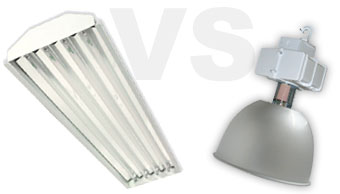T5HO High Bay Compared to 400W Metal Halide High Bay
 We're often asked how 4-lamp T5HO High Bays and 6-lamp T5HO High Bay Fixtures fare when compared with traditional 400W Metal Halide fixtures. The chart below compares 4-lamp and 6-lamp T5 fixtures against a traditional 400W Metal Halide High Bay along a number of dimensions. The comparison dimensions are listed below with a short description of each.
We're often asked how 4-lamp T5HO High Bays and 6-lamp T5HO High Bay Fixtures fare when compared with traditional 400W Metal Halide fixtures. The chart below compares 4-lamp and 6-lamp T5 fixtures against a traditional 400W Metal Halide High Bay along a number of dimensions. The comparison dimensions are listed below with a short description of each.
400W MH Compared to 4-Lamp and 6-Lamp T5 HO High Bays
| Comparison Dimension | 400W Metal Halide | 4-Lamp T5 High Bay | 6-Lamp T5 High Bay |
| Number of Lamps | 1 | 4 | 6 |
| Lamp Watts (W) | 400 | 216 | 324 |
| Fixture Watts (W) | 455 | 234 | 351 |
| Initial Lumens | 35,000 | 20,000 | 30,000 |
| Mean Lumens | 21,000 | 19,400 | 29,100 |
| End of Life Lumens | 15,750 | 18,000 | 27,000 |
| Rated Lamp Life (hrs.) | 20,000 | 25,000 | 25,000 |
| Conventional Lumens per Watt | 75-85 | 90-104 | 90-104 |
| Color Rendition Index | 60-70 | 85-98 | 85-98 |
| Yearly Operating Cost | $130.13 | $66.07 | $100.39 |
| Strike Time | 4 mins. | <1.5 sec. | <1.5 sec. |
| Re-strike Delay | 10 mins | <1.5 sec. | <1.5 sec. |
| Multi-level Switching Capability | No | Yes | Yes |
| Occupancy Sensor Friendly | No | Yes | Yes |
Comparison Dimensions
Below you will find a description of the dimensions used to compare the standard 400W Metal Halide fixture against the 4-lamp and 6-lamp T5HO High Bay fixtures.- Number of Lamps: This is the total number of lamps contained in the fixture. It may seem trivial, but when you realize that you could be left in the dark when a single lamp fails in a 400W MH system, the implications are obvious. Even though there are more lamps in a T5 system, the lamps are less expensive to replace.
- Lamp Watts: This describes the total amount of power in watts consumed by just the lamps in the system.
- Fixture Watts: This details the total amount of power in watts consumed by the entire light system. This is the sum of the lamp watts and the ballast power consumption. It's important to note that when comparing a Metal Halide high bay with a T5 high bay, the Metal Halide high bay ballast consumes much more power than the T5 high bay ballast.
- Initial Lumens: This describes the rated light output for the specific lamp type at the beginning of its useful life.
- Mean Lumens: This describes the rated light output for the specific lamp type at approximately 40% of its useful life. Notice the steep depreciation in lumen output for the standard 400W metal halide when compared with the T5 fixtures.
- End of Life Lumens: This describes the expected light output for the specific lamp type at approximately 95% of its useful life. While the T5-based systems have only a small amount of depreciation, the 400W Metal Halide fixture continues its steep lumen drop throughout its life. The Metal Halide fixture is still consuming 100% of the rated power, but converting less and less of this energy into light. The remaining energy is wasted as heat.
- Rated Lamp Life: This is the number of hours the manufacturer has rated these lamps to function as specified. These lamps are typically rated at 10 hours per start. At or near the end of life, metal halide lamps are known to "cycle." This means they turn on, heat up, turn off and repeat.
- Conventional Lumens per Watt: This dimension compares the amount of light output per system watt. It is a measure of efficacy for the fixture. The higher the number, the more light you can get for a given amount of power.
- Color Rendition Index: The Color Rendition Index (CRI) is the measure of the ability of a light source to reproduce the colors of various objects faithfully in comparison with an ideal or natural light source. The lower CRI negatively impacts visual acuity and can strain the eye.
- Yearly Operating Cost: This is the dollar amount it costs to operate a single fixture for one year assuming 10 hours per day, 5 days per week, 52 weeks per year and $0.11 per kWh energy cost.
- Strike Time: This comparison dimension identifies the delay required to bring the lamp to full brightness from a cold start.
- Re-strike Delay: This comparison dimension identifies the delay required to bring the lamp to full brightness between starts. This is pertinent when power is temporarily lost. Facilities that use metal halide lighting would have to rely on emergency lighting during the re-strike delay. For facilities that use T5 lighting, the fixtures would turn back on almost instantly.
- Multi-level Switching Capability: This comparison dimension identifies if the particular fixture can be configured to have multiple levels of brightness. Some newer metal halide fixtures do offer this function, but the traditional fixtures did not. The multi-lamp nature of T5 systems makes multi-level switching very simple. Modern T5HO ballasts even include extra switch legs to allow for simple switch or sensor wiring.
- Occupancy Sensor Friendly: This identifies if the fixture works well with occupancy-based sensing systems. Occupancy sensors can significantly cut energy consumption when applied in low-use areas. The strike/re-strike times associated with metal halide lights prevents their use in these fixtures.
December 17, 2009






